Dremel Bits for Rocks: A Complete Guide
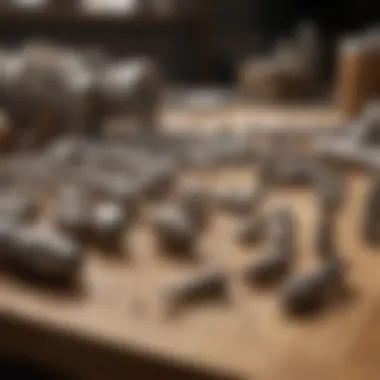
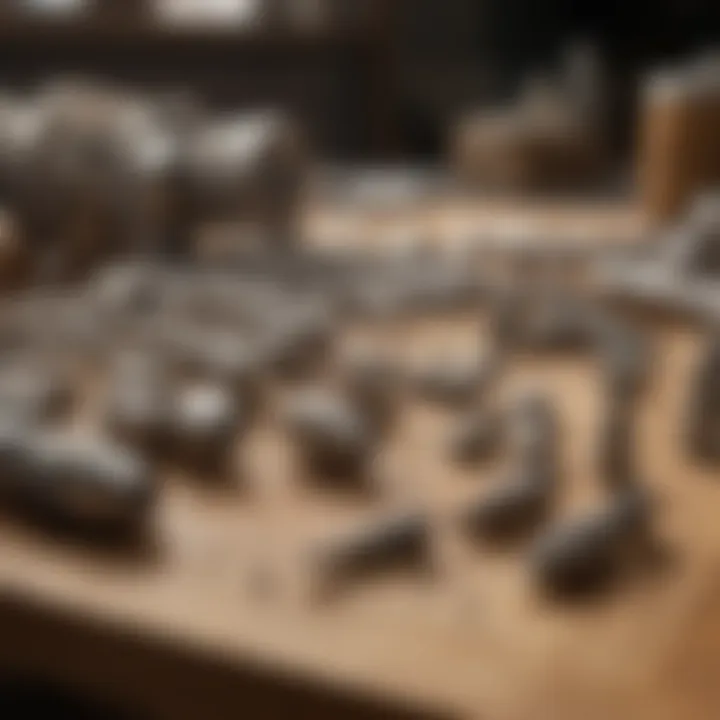
Intro
Rock collecting is not just a hobby; it's a passion that connects enthusiasts with nature's history. When it comes to working on rocks and minerals, having the right tools can make all the difference. Dremel bits, specifically tailored for various rock types, can transform the experience from amateur to expert.
In this guide, you'll find crucial information about selecting the most suitable Dremel bits for your rockwork needs. The following sections delves into different types of bits available, their specific applications in rock collecting, and practical techniques to ensure safe usage. Whether you're just dipping your toes into this fascinating field or you're a seasoned collector, this comprehensive resource aims to enhance your skill set and understanding.
Given the unique properties of rocks, selecting the right bit can be daunting. However, it’s not all just grind and perseverance; understanding the nuances of each bit can significantly elevate your craftsmanship. Let’s begin our journey into the world of Dremel bits.
Prelude to Dremel Tools
When diving into the art of working with rocks, understanding the tools available is paramount. Dremel tools serve as a cornerstone in this field, thanks to their remarkable versatility and precision. They allow hobbyists and experts alike to carve, shape, and refine a myriad of rock types with ease. Knowing how a Dremel tool functions and the capabilities it offers can significantly enhance one’s rock working experience.
Understanding Dremel's Versatility
Dremel tools are often viewed as a jack-of-all-trades in the realm of crafting. They come equipped with a variety of attachments, but the real magic lies in the assortment of bits you can use. Depending on the project at hand, different bits can be swapped in to achieve specific tasks. This adaptability makes Dremel tools not only suitable but also essential for rock enthusiasts. Whether one is drilling holes through hard stones or polishing gemstones, the right Dremel bit can make the job simpler and more effective.
Using Dremel tools offers convenience and precision. With a steady hand, you can execute intricate designs or smooth out surfaces with remarkable accuracy. This versatility allows for everything from tiny, detailed carvings to more general shaping of larger stone pieces. In fact, many collectors have found that having a Dremel in their toolkit has opened up numerous possibilities for creativity and exploration.
Applications in Rock Work
The applications of Dremel tools in rock work are nearly endless. Here are a few notable uses that rock and fossil collectors may find advantageous:
- Drilling: The ability to create holes in various rock types is crucial for many projects. Whether it's for creating jewelry or mounting specimens, Dremel tools provide the precision needed to drill holes without cracking the material.
- Carving: For those looking to create sculptures or detailed designs, a Dremel allows for fine carving that manual tools may struggle with. It’s easier to achieve delicate lines or texturing, making your work shine.
- Smoothing and Polishing: After a piece has been shaped, many collectors use Dremel tools to polish rocks, enhancing their luster. This finish can make your specimens stand out in a collection.
"The right Dremel bits can transform rough stones into stunning works of art, revealing the hidden beauty within each piece."
- Engraving: Custom engraving on stones adds a unique touch to collectibles or individualized projects. This can be particularly popular for personalized gifts.
By familiarizing oneself with these applications, both novice collectors and seasoned rockhounds can maximize their creativity and effectiveness when working with stones. In essence, understanding Dremel tools and their uses is the first step to mastering the craft of rock work.
Types of Dremel Bits for Rocks
Understanding the different types of Dremel bits for rock work is crucial for anyone looking to tackle projects ranging from simple polishing to intricate carving. Each type of bit possesses unique features designed to handle specific tasks, which can drastically influence the quality of your work. Using the right bit not only enhances efficiency but also ensures that you achieve a professional finish without damaging your materials. Whether you're a hobbyist crafting jewelry or a fossil collector needing precision, being familiar with the various bits available can elevate your projects significantly.
Diamond Bits
Diamond bits are among the most sought-after tools for anyone working with tough materials like stone and glass. These bits are coated with tiny diamond particles, which makes them exceptionally durable and effective at cutting through hard surfaces. One of the standout benefits of diamond bits is their versatility; they can perform a myriad of tasks ranging from drilling to grinding and polishing.
When selecting diamond bits, size and shape matter. Round bits are great for precision holes, while flat bits excel at surface grinding. In practical terms, if you're aiming to create a smooth, glossy finish on a rock, a diamond polishing bit will work wonders.
"A diamond bit can mean the difference between rough edges and polished perfection."
Carbide Bits
Carbide bits represent another essential category. Made from tungsten carbide, they are robust tools often used for carving and shaping rocks, woods, and metals. One major advantage of carbide bits is their ability to perform well on various materials, which makes them a good choice for multipurpose crafting.
In rock work specifically, these bits can be particularly effective on softer stones. They come in diverse shapes, including cylindrical and tapered, enabling you to achieve diverse designs and cuts. If you're working on a softer material and need a clean cut, definitely consider carbide.
Grinding Stones
Grinding stones serve as foundational tools in rock work, allowing artisans to refine surfaces and create intricate details. They come in different grits, and selecting the right one plays a vital role in your workflow. Coarse grits remove material quickly, while fine grits allow for detailed finishing.
These bits can be particularly useful when prepping stones for polishing. When you need to bring out the unique patterns in your rock, a grinding stone can effectively highlight these features before you move onto finer polishing stages. Always keep in mind, the right grinding stone can simplify your process and enhance the final result.
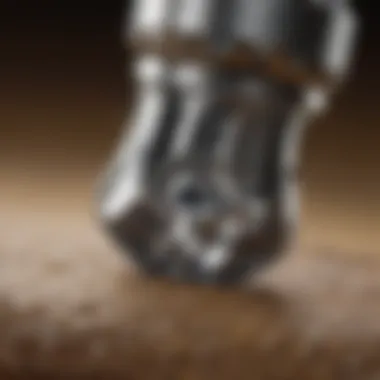

Sanding Drums
Sanding drums round out the bit options available for rock work. These cylindrical sleeves are perfect for smoothing surfaces and can fit onto a variety of Dremel tools easily. Their adaptability allows for a wide range of applications from shaping to fine-tuning your projects.
When using sanding drums, it's essential to select the appropriate grit depending on the level of smoothness you desire. Lower grit numbers are great for initial shaping, while higher numbers are better for achieving that final smooth texture you seek. Overall, they are indispensable in crafting and finishing your rock projects.
Selecting the Right Bit for Your Project
Choosing the right Dremel bit for your rock work can be the difference between a satisfying experience and a frustrating endeavor. Each type of rock has its own specific characteristics, which means that not all bits will work effectively across all materials. The importance of selecting the appropriate bit cannot be understated—it opens the door to successfully achieving your project goals while preventing damage to both the rock and your tools.
Understanding the key elements involved in selecting the right bit enhances both your efficiency and the quality of your work. It isn't merely about grabbing any bit from your toolbox; rather, it’s a matter of analyzing the nuances of the task at hand. You may think that all bits are created equal, but the subtle differences in design can yield vastly different results.
Consider the Rock Type
When it comes to rock work, the first question should always be: What type of rock am I working with? The composition of rocks varies greatly—from soft sedimentary stones to hard igneous formations—so knowing the type of rock can guide your bit selection with precision.
- Sedimentary Rocks: Rocks like sandstone or limestone are generally softer. A diamond bit or a carbide bit would work well here, giving you a smooth cut or polished finish.
- Igneous Rocks: When tackling granite or basalt, you'll need something tougher. Diamond bits are ideal for these hard materials, as they can handle the density and toughness seamlessly.
- Metamorphic Rocks: For slates or schista, a grinding stone might be the best approach to handle their layered structure without overwhelming them.
The wrong choice can easily lead to fractures or an unsatisfactory finish, wasting both time and resources.
Assessing Bit Sizes
Once you’ve zeroed in on the type of rock, the next consideration is the size of the bit. Bits come in various diameters, and the size you choose should be directly related to the specifics of your project. A larger bit may cover more area quicker but could also risk losing precision, especially in detailed work. Conversely, a smaller bit offers more finesse but can take longer to achieve the desired effect.
- Small Bits: Ideal for detailed engraving or working on delicate sections of your rock. Great for jewelry creation or meticulous designs.
- Medium Bits: These are versatile—suitable for general shaping and smoothing tasks right across the rock spectrum.
- Large Bits: When working on larger surfaces or removing larger chunks, they are your go-to.
Balancing between precision and efficiency in your selection makes a significant impact on your progress and end results.
Understanding Speed Settings
Different projects will call for different speeds. A common mistake among beginners is not adjusting the speed of the Dremel tool according to the materials being used and the bit type.
- Low Speed: Generally, a lower speed (around 5,000 to 10,000 RPM) is appropriate for softer materials or when precision is crucial. This allows better control, reducing the chances of burning the bit or the rock.
- High Speed: Higher speeds (10,000 RPM and above) work well for harder rocks, where faster rotations help to efficiently cut through tougher materials. However, caution is needed here since excessive speed can lead to overheating and damage.
Techniques for Using Dremel Bits
When undertaking any rock work with a Dremel tool, the techniques employed can significantly influence the outcome of your project. It's not just about the type of bit you choose, but how you use that bit which can make all the difference between a polished gem and a fractured mess. Mastering these techniques leads to cleaner cuts, better finishes, and ultimately a more enjoyable experience placing you a notch above the rest in your rock collecting endeavors.
Basic Operating Techniques
Before jumping into your project, it’s crucial to understand the fundamental techniques that lay the groundwork for effective operation of your Dremel tool.
- Grip and Control: Hold your Dremel firmly, but avoid excessive pressure. Too tight a grip can lead to mistakes. Use your fingers to guide the tool gently as this gives you precision, allowing the bit to do the job it’s designed for.
- Correct Speed Adjustment: Start with a lower speed setting and increase gradually as needed. Different materials respond uniquely; stones might require slower speeds compared to softer materials like wood.
- Regular Cleaning: Make it a habit to clean your bits before and after use. This not only ensures longevity but also enhances performance, as a dirty bit can affect cutting efficiency.
- Angle of Approach: Angle matters! Adjust your approach depending on the material; for detailed work, a slight angle can prevent chipping and allow for smoother strokes, while a perpendicular angle is generally useful for deeper cuts.
By adhering to these basic techniques, you're setting yourself up for success. A straightforward tip is to practice on scrap materials before moving on to your prized specimens. This builds your confidence and ensures you're ready when it matters.
Advanced Techniques
Once the basics are under your belt, it’s time to elevate your skills with advanced techniques that can add flair and precision to your projects.
- Layering Cutting Techniques: For intricate designs, consider using a layering approach. Start with a rough shape and gradually refine it. This ‘carving down’ method is excellent for achieving depth and detail.
- Use of Templates: When working on particularly complex pieces, consider making or using templates. They serve as a guide and can help maintain uniform shapes. Lay the template right onto your stone and trace with your bit, ensuring every detail is captured.
- Mixing Bits: Don’t hesitate to mix different types of bits. A combination of grinding and polishing bits can lead to stunning effects, especially on soft minerals where achieving both structure and sheen is essential.
- Soft Touch Technique: This technique involves a gentle touch at the end of your cuts. Lightly lift your bit as you finish your stroke; it helps to avoid burrs and provides a clean finish.
- Cool Down Periods: Overheating can reduce the life of your bits and damage your materials. Give your tool and rock a break every couple of minutes; this ensures precision without fatigue on either end.
“The right technique can turn a simple rock into a masterpiece.”
Combining elegance and control will refine your skills further, allowing you to explore engraving, shaping, or polishing in ways that novice users might not even consider.
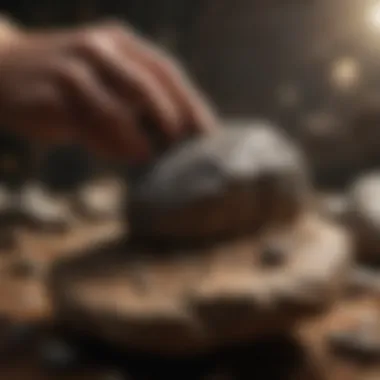

By mastering these operating techniques, from the basic to the advanced, you’ll find yourself not just working with Dremel bits but truly orchestrating the art of rock work. Keep in mind that every stroke is a step towards your own growth as a talented rock collector and artisan.
Safety Precautions
When delving into rock work with Dremel tools, safety should never take a back seat. Working with various materials like stones and minerals can produce dust, flying debris, and even noise, which can be hazardous if proper precautions aren't taken. Ensuring safety not only protects the individual but also enhances the overall working experience. Let’s break down the crucial elements that all enthusiasts should bear in mind before starting their projects.
Personal Protective Equipment
First off, let’s talk about Personal Protective Equipment (PPE). Wearing adequate protective gear is essential in minimizing risks during rock work. Here are some essentials to consider:
- Safety Goggles: Dust and small particles can fly around when you’re grinding or carving. A good pair of safety goggles will shield your eyes from any unwanted hazards.
- Dust Mask or Respirator: Particularly when dealing with materials that generate dust, like quartz or limestone, a dust mask or even a respirator is vital. It helps in keeping those fine particles out of your lungs, reducing the risk of respiratory issues.
- Hearing Protection: Dremel tools can be noisy. If you are running them for extended periods, using earplugs or earmuffs can safeguard your hearing.
- Gloves: Though gloves can offer a layer of protection, ensure they are appropriate for the task. Thin gloves may snag, whereas thick ones might hinder your dexterity. Opt for cut-resistant gloves designed for precise tasks.
Using these protective items is like putting on armor before heading into battle. You’re less likely to get injured, allowing you to focus on your craft.
Proper Ventilation and Dust Control
Next, let’s shine a light on Proper Ventilation and Dust Control. This might sound obvious, but many might overlook this aspect while getting absorbed in their projects. Here’s why it’s critical:
- Reduce Dust Accumulation: Adequate ventilation minimizes the buildup of dust and particulates in the workspace. Whether working indoors or out, ensure that air can flow freely to carry away any pollutants.
- Use of Exhaust Fans: If you're in a closed space, consider having an exhaust fan or even a simple window open. This helps in pushing out the dust-laden air and replacing it with fresh air.
- Dust Extraction Systems: For those serious about their craft, investing in a dust extraction system could be worthwhile. This equipment can significantly lower dust levels and keep your workspace cleaner.
- Wet Techniques: In certain cases, like cutting softer stones, using water can lessen dust generation. It transforms the airborne dust into heavier particles, which settle instead of floating around.
"Safety isn’t just a set of rules; it’s a way of life in rock working. Pay attention to PPE and maintain good ventilation for a smoother experience."
Maintenance of Dremel Bits
Maintaining Dremel bits is critical for anyone engaged in rock work. Just like any precision tool, proper care and upkeep can ensure that these bits perform optimally over time. The benefits of maintaining Dremel bits extend beyond just the immediate performance; they also save on replacement costs and enhance the overall quality of your rockworking projects.
Regular maintenance not only prolongs the life of the bits but also provides better results during crafting and processing rocks. Over time, bits can accumulate dust, debris, and residue from various materials, which can interfere with their effectiveness. Therefore, a thoughtful approach to maintenance can prevent many common issues that surface due to neglect.
Cleaning Your Bits
Keeping your Dremel bits clean is essential for both performance and safety. When you use your tools on rocks, they can quickly gather bits of material, which may obstruct proper functioning. Here’s a step-by-step approach to cleaning your bits:
- Use a Soft Brush: After each use, gently brush off any residue with a soft-bristled brush. This can include a toothbrush or an old paintbrush. Make sure to do this while the bit is still attached to avoid potential buildup.
- Rinse Under Water: For deeper cleaning, especially on diamond or carbide bits, rinse them under warm water. Avoid using harsh detergents or chemicals, as these can damage the bits.
- Ultrasonic Cleaner: If you're serious about your craft, consider investing in an ultrasonic cleaner. This device can remove stubborn debris, ensuring that even the small nooks and crannies of your bits are completely cleaned.
"A clean bit means a happy bit! Keep your tools tidy to enjoy a smoother crafting experience."
- Dry Thoroughly: After cleaning, dry the bits thoroughly before storing them. Moisture can lead to rust and corrosion.
These cleaning steps provide a comprehensive method of keeping your Dremel bits in prime condition, leading to better performance in your rock projects.
Storing Dremel Bits
Proper storage of Dremel bits is just as crucial as cleaning them. Incorrect storage can lead to damage, and that means a shortened lifespan and less effective tools. Here’s how to store your bits wisely:
- Use a Bit Holder: Many hobbyists opt to use a dedicated holder specifically designed to keep Dremel bits organized. This prevents bits from knocking against each other and minimizes the risk of chipping or breaking.
- Avoid Damp Areas: Since moisture can accelerate rust, always store your bit collection in a dry environment. Controlling humidity can make a world of difference.
- Label Storage: For bit organizations, label your storage containers. When in the heat of crafting, the last thing you want is to be searching for the right size or type of bit. Knowing where everything is saves time and frustration.
- Protective Cases: If you frequently transport your Dremel bits, use protective cases. This will protect them from shock and excessive movement during transit.
By paying attention to how you store your Dremel bits, you ensure their longevity and prepare yourself for smoother, more effective rockworking down the line.
Common Mistakes and How to Avoid Them
Working with Dremel bits, especially when focused on rocks, comes with its own set of challenges. Making mistakes during the process not only leads to poor results but can also damage your tools and materials. Understanding common pitfalls can save time, effort, and resources and can transform your experience from frustrating to fulfilling. This section highlights key errors often made and offers practical advice on how to sidestep them.
Using Incorrect Speed Settings
One of the major missteps new users often make is selecting the wrong speed when working with different types of rock. Dremel tools typically offer a range of speed settings, and each bit has its ideal range. For instance, working with softer materials like alabaster can benefit from a lower speed, as it reduces the risk of chipping. Conversely, harder stones like quartzite may require a higher speed to achieve effective removal without excessive pressure. Using the wrong setting could not only compromise the finish but also lead to bit wear or breakage.
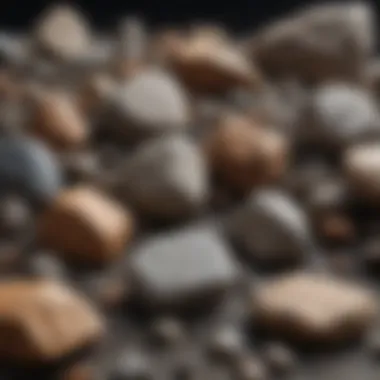
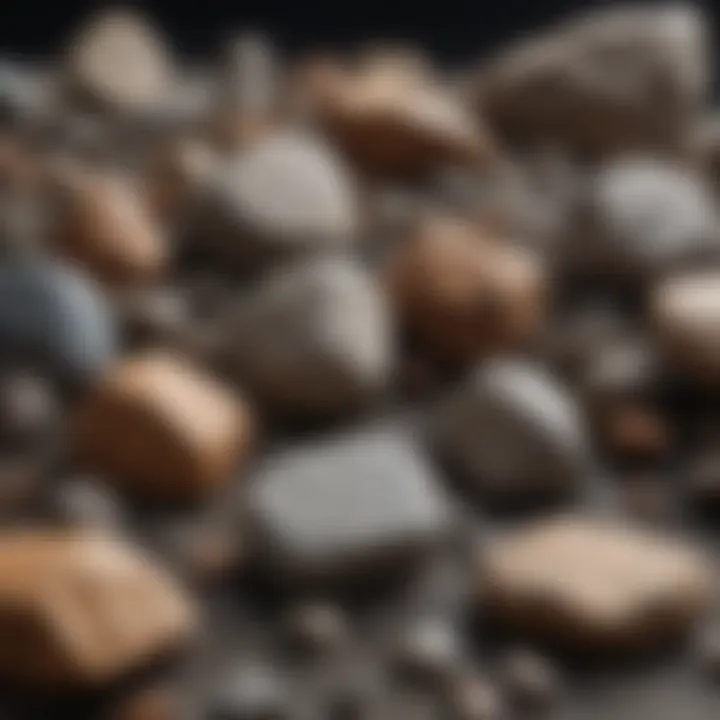
- Recommendations for Speed Settings:
- Softer Rocks: Low (5000 - 10000 RPM)
- Medium Hardness: Medium (10000 - 15000 RPM)
- Hard Rocks: High (15000 - 35000 RPM)
Another crucial rationale behind adjusting speeds is heat generation. When moving too quickly, heat can build up, risking melting the bit or damaging your workpiece. Always start at a lower speed, gradually increasing until you find a comfortable rhythm that works for the material at hand.
"Get to know your equipment; understanding each component's strengths leads to better outcomes."
Applying Excessive Pressure
Another frequent error is applying too much force while using Dremel bits. It's a common misconception that heavier pressure equates to faster work. In reality, excessive pressure can lead to several issues:
- Bit Breakage:
Applying too much pressure can quickly overwhelm the bit, causing it to snap under stress, especially with finer bits or softer materials. - Poor Finish Quality:
Instead of cutting through material cleanly, increased pressure may cause tearing or chipping, leading to an uneven surface. - Operator Fatigue:
The harder you push, the more tired your hands and arms can get, which increases the risk of mistakes.
Instead, allowing the bit to do the work is key. Light, consistent pressure applied in a steady manner will yield better results. Also, it’s often helpful to take regular breaks and reassess your method and progress. Moreover, practice makes perfect! Knowing how much pressure to apply typically comes with experience and familiarity with your tools.
By steering clear of these pitfalls, your rock work will become more efficient and enjoyable. Arming yourself with knowledge is just as important as the tools you choose.
Case Studies: Successful Rock Projects
In the realm of rock work, practical examples can illuminate the often complex decision-making processes behind bit selection and technique. Case studies lend a personalized touch to understanding nuances in using Dremel tools on various geological materials. By examining previous successes, enthusiasts can glean insights that not only elevate their own projects but also help in avoiding potential pitfalls. The lessons learned in these narratives address varied aspects such as technique, material compatibility, and the creative use of tools, serving as invaluable resources for both budding users and seasoned collectors.
Jewelry Creation
Creating jewelry from stone using Dremel bits is an art form that blends precision and creativity. One notable case involved a hobbyist who ventured into designing pendants with turquoise stones. The initial challenge was knowing which type of Dremel bit to use, given the stone’s unique hardness and coloration. Ultimately, the user opted for diamond bits known for their ability to carve and polish without causing significant damage to the delicate materials.
- Step-by-step process:
- Shaping: The hobbyist started with a coarse diamond bit to achieve the desired shape of the turquoise. This bit allowed for effective control over the contours and edges.
- Smoothing: Next, a finer diamond bit was employed to refine the surfaces. This crucial step eliminated rough edges and enabled the creator to work on the details, enhancing the visual appeal of the pendant.
- Polishing: Finally, the use of polishing bits revealed the gemstone's luster, resulting in a striking focal piece.
The success of this project did not only stem from the tools but also from the careful planning and execution of techniques tailored to the stone's properties. This example serves as a reminder that understanding both the material and the applicable Dremel bits can be the difference between a mediocre piece and a stunning jewel.
Sculpting and Customizing
The world of sculpting with Dremel tools showcases creativity in transforming ordinary rocks into exquisite art pieces. In one memorable project, an artist embarked on creating a small-scale sculpture from a block of soapstone. This project highlighted several critical points regarding the selection of Dremel bits and techniques.
- Key phases of the project:
- Initial Roughing: The artist began with a carbide bit to remove large sections of soapstone. Carbide is preferred here as it maintains durability while effectively taking away material.
- Detailing: For the more intricate aspects of the sculpture, the artist switched to diamond bits. These bits allowed for detailed work on features such as facial expressions and textures, essential for bringing any sculpture to life.
- Final Touches: The finishing touches involved grinding stones for additional smoothing and polishing to highlight soapstone's natural beauty.
This case illustrates that thoughtful selection and application of Dremel bits can amplify an artist's vision, resulting in remarkable sculptures that captivate viewers. Observing another's project can serve as motivation while also providing a blueprint for achieving personal artistic goals.
Epilogue and Final Thoughts
In wrapping up this comprehensive guide, it’s crucial to underscore the significance of understanding Dremel bits for tackling rock work. These bits don’t just serve the purpose of engraving or cutting; they unlock a world brimming with potential creativity and discovery for both hobbyists and collectors. Mastering the use of these tools equips you with the skills to customize and refine your rock projects while minimizing frustration and maximizing results.
Recap of Key Points
As we draw our exploration to a close, let’s recap the pivotal elements discussed:
- Dremel Bit Types: We explored various types, including diamond bits, carbide bits, grinding stones, and sanding drums, each tailored for specific tasks and rock materials.
- Selection Criteria: Adequate attention was given to selecting the right bit based on rock type, size necessities, and speed settings, ensuring optimal performance and outcomes.
- Techniques for Use: Techniques covered from basic operation to advanced methods maximize the efficiency and effectiveness of your projects.
- Safety Measures: We discussed the critical importance of utilizing appropriate safety gear and dust control methods.
- Maintenance Insights: Keeping your bits clean and stored correctly leads to longevity and better functionality.
- Avoiding Common Mistakes: Awareness of pitfalls, like incorrect speed settings or over-pressuring bits, can save you from costly mishaps.
Understanding and implementing these key points not only enriches your rockworking approach but also enhances your overall experience with Dremel tools.
Encouragement for Continued Exploration
With the foundational knowledge detailed throughout this guide, consider this just the beginning of your journey with Dremel tools. The beauty of rock work lies in its limitless possibilities. Engage with community forums, such as Reddit or local collector groups on Facebook, to share your experiences and learn from others. Exploring alternative techniques and experimenting with different rock types will deepen your understanding and skill set.
For those eager to push the envelope of creativity, try advanced projects that challenge your current knowledge base. Perhaps designing intricate jewelry pieces or sophisticated sculptures can be your next goal. The skills you master now can translate into rewarding creations that resonate with your personal artistic expression.
Take this opportunity to venture beyond comfort zones and immerse yourself in the fascinating world of rocks and minerals. Your tools might just be the magic wand in your creative endeavors.



